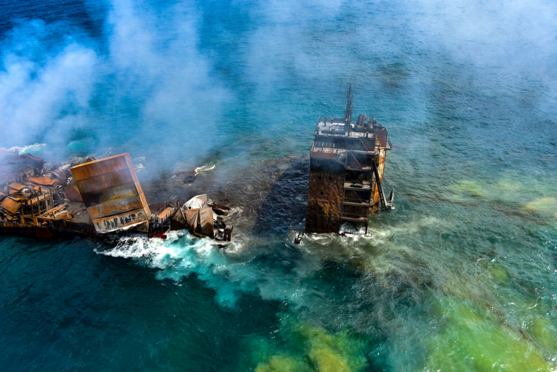Sri Lanka eyes major compensation case over X-Press Pearl sinking
By Malaka Rodrigo
COLOMBO — Sri Lanka has received $2.5 million in the third interim payment for the impacts caused by the sinking of the X-Press Pearl cargo vessel off the country’s western coast 14 months ago. This is the third tranche of compensation, but Sri Lankan authorities say a much larger claim for the environmental damage is still to be filed.
The latest payment brings the total paid by the ship’s insurer to $7.85 million. Sri Lanka received $3.6 million in July 2021, shortly after the June 2 sinking that was caused by a fire on board the Singapore-flagged X-Press Pearl, and another $1.75 million in January this year. These payments are mainly to reimburse the government for the cost of the emergency response operations and for direct damages and clean-up, said Darshani Lahandapura, chair of Sri Lanka’s Marine Environment Protection Agency (MEPA).
“The latest receipt will be distributed among 15,032 fishermen belonging to the fishing communities in the three districts of Colombo, Gampaha and Kalutara,” said Susantha Kahawatta, director-general of the Department of Fisheries and Aquatic Resources (DFAR).
International legal battle pending
The sinking of the ship, which was carrying various chemicals and plastic pellets, led to large-scale pollution reported in the immediate coastal area and was blamed for killing several marine animals. The outflow of the more than 50 billion plastic pellets, known as nurdles, made this the worst plastic marine pollution event in the world, prompting the government to impose a fishing ban along a 50-kilometre (31-mile) stretch of the island’s western coast for more than a month. This particularly affected the artisanal fishers in the region, who lost their only source of livelihood during this period.
The X-Press Pearl was carrying 1,486 containers when it caught fire off Colombo on May 20, 2021, and began sinking. Eighty-one of the containers were labelled ‘hazardous’, and the cargo included 25 metric tonnes of nitric acid — a key ingredient in the production of explosives, and touted as a possible factor for the fire. There were several explosions, and it took more than a week to bring the fire under control. Attempts to tow the vessel to deeper waters failed, and the freighter finally sank on June 2, 2021, a few kilometres off Sri Lanka’s western coast, becoming the worst maritime disaster in Sri Lankan waters.
The sheer scale of the disaster should be reason enough to “fight to get proper compensation for the country,” said Dan Malika Gunasekera, an expert in maritime law. He cited compensation claims filed by other countries over similar incidents to estimate that Sri Lanka should be able to secure between $5 billion and $7 billion. The inevitable legal battles could be strenuous, as Sri Lanka needs to secure these claims according to international maritime law, which means filing these claims early, Gunasekera said.
But more than 14 months since the incident, Sri Lanka has still not filed a claim for the environmental damage suffered, which is being assessed by a panel of experts convened by the MEPA.
“This environmental damage assessment report is now ready and it was submitted to the Attorney General’s Department for instituting necessary actions,” Lahandapura said.
Environmentalists push for compensation
The Centre for Environmental Justice (CEJ), a local advocacy group, plans to file three lawsuits in the X-Press Pearl case.
“Sri Lanka has not ratified certain conventions, which would have helped the island to mount compensation claims for maritime disasters of this kind and of this magnitude,” said CEJ chair Ravindranath Dabare, a prominent environmental lawyer, noting, “CEJ together with other concerned organizations is hence pushing the authorities to take action and filed a case in June 2021 to demand compensation for the affected parties.”
The group is set to file two more cases to ensure the authorities act in a timely manner to secure compensation and completion of the beach clean-up process.
Lahandapura said the MEPA is currently fine-tuning the environmental damage report in consultation with Australian legal experts to ensure the claim stands a strong chance of succeeding in international litigation.
“We cannot unduly expedite the process, as it is an international legal process,”
Another compensation case
The case of another ship could indicate how Sri Lanka’s claims over the X-Press Pearl sinking play. The Attorney General’s Department filed a compensation claim for up to $44 million against the Greek owners of the crude oil tanker the New Diamond on Sept. 3 — the deadline for filing such a claim.
The Panama-flagged ship caught fire off the western coast of Sri Lanka on Sept. 3, 2020, while carrying 270,000 metric tonnes of crude oil and 1,700 metric tonnes of bunker oil. A crew member was killed in the incident, but intensive efforts by the Sri Lankan and Indian navies, as well as two Russian naval vessels that were in the area for joint exercises at the time, managed to prevent the oil spilling and the ship sinking. The New Diamond was eventually towed away to a shipbreaking yard in Pakistan.
The Parliamentary Committee on Public Enterprises (COPE) noted that Sri Lanka has since received only $6 million in reimbursement and compensation, out of a potential $44 million that it could claim under the Civil Liability Act. But the claim to this full amount must be filed within two years of the New Diamond catching fire, which was Sept. 3 this year.
Lahandapura said that with the MEPA’s support, the Attorney General’s Department filed the case at the last minute.
As for the wreck of the X-Press Pearl, salvage operations have been handed over to the Shanghai Salvage Company. The ship’s owners, Singapore-based X-Press Feeders, said the salvation operation may take at least another year, and is currently on hold due to rough seas along Sri Lanka’s western coast during the monsoon season.
-news.mongabay.com



Comments are closed, but trackbacks and pingbacks are open.